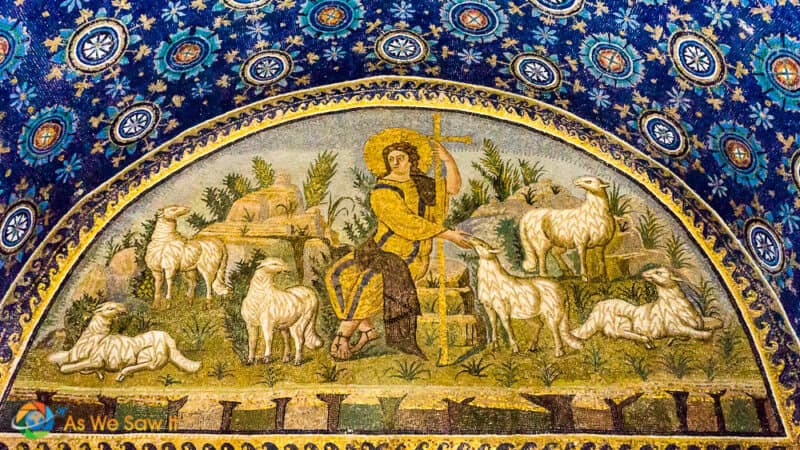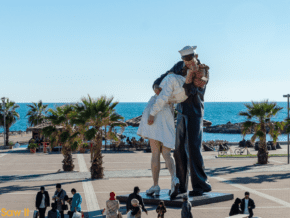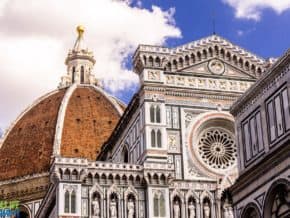It's a shame that so few people have heard of Ravenna Italy or its exquisite mosaics. They're missing out on a real treat. Any visit to Italy deserves at least one day in Ravenna, and it's easy to do because this lovely city is easy to reach by train from Venice, Bologna, and Florence.
Ravenna is worth visiting if you're interested in mosaics, history, or architecture. Plus, the city's inexpensive lodgings and eateries provide excellent value for travelers on a budget.
Located in Emilia-Romagna, Ravenna is best known for its exquisite 5th and 6th-century Byzantine mosaics. The best examples adorn eight Early Christian monuments that are listed as UNESCO World Heritage Sites.
A bit of Ravenna history (who knew?)

Back in Roman times, Ravenna went by the name of Classe. It served as an imperial port for the empire's massive naval fleet and was even—for a brief time—the capital of eastern Rome (from 402 until the empire collapsed in 476).
Ravenna was the capital of the Ostragoth empire until 540, when the Byzantine emperor Justinian re-conquered the city and made Ravenna the westernmost pillar of the Holy Roman Empire.
In a nutshell, this explains why there are so many churches and Istanbul-quality mosaics here.
What are the 8 UNESCO sites in Ravenna?
Eight early Christian churches/monuments in Ravenna qualify as UNESCO sites. They include:
- Baptistry of Neon (c. 430)
- Mausoleum of Galla Placidia (c. 430)
- Arian Baptistry (c. 500)
- Archiepiscopal Chapel (c. 500), also called the Archbishop's Chapel
- Basilica of Sant'Apollinare Nuovo (c. 500)
- Mausoleum of Theodoric (520)
- Basilica of San Vitale (548)
- Basilica of Sant'Apollinare in Classe (549)
We couldn't visit every one of the sites, because we were only in Ravenna for one day. But no matter. The mosaics we did manage to see were exquisite. Jaw-dropping, even.


Each mosaic was created with painstaking care and meticulous attention to detail. At first, it appears to be a captivating tableau of a sea voyage, an image of Jesus, or a celestial choir of angels. Then you step closer, and those exquisite images transform into an incredible collection of tiny tiles in bright and golden hues.
I couldn't help but wonder how much time each of these mosaics must have taken to create. What talent they had!
How to make Byzantine mosaic tiles
If you're interested in how they created these incredible works of art, you'll enjoy this fascinating 3-minute video:
One day in Ravenna, Italy
Ravenna has a lot to offer visitors in addition to the world-famous mosaics. Art lovers will enjoy Ravenna's many museums and art galleries, while foodies will enjoy the city's many restaurants, cafes, and gelaterias.
The city is home to several important historical sites, including the Mausoleum of Galla Placidia, Sant'Apollinare Nuovo, and San Vitale.
So whether you're interested in history, art, or food, or simply want to enjoy the sights and sounds of this vibrant city, Ravenna is sure to please.
Here are the best things to see and do in Ravenna in one day.
Mausoleum of Galla Placidia

According to UNESCO, the Mausoleum of Galla Placidia is “the earliest and best preserved of all mosaic monuments, and at the same time one of the most artistically perfect.”
I can't imagine how they were able to choose which locations to include. Every one of the sites is just as artistically perfect, in my opinion.
The mausoleum is illuminated by luminous alabaster window panels, which give the artwork an ethereal glow.


Galla Placidia, daughter of Roman Emperor Theodosius I, was a well-known patron of the arts. Legend has it that she had this built as a mausoleum for her and her family. Three sarcophagi are housed there.
While no one is 100% certain, one sarcophagus is said to he hers, a second belongs to her husband, Emperor Constantius III, and the third holds the remains of either Galla's son, Emperor Valentinian III, (Galla's son) or of Emperor Honorius, her brother.
Arian Baptistery

Theodoric the Great, king of the Ostrogoths, erected the Arian Baptistery as a political move. Two influential groups in his empire, the Goths (Arians) and the Latins (Orthodox), had different views of Christ and only one of them had a baptistery.
To keep the peace, Theodoric built this baptistery “of the Arians” in order to distinguish it from the Baptistery of Neon (of the Orthodox) that had been built a century before.
The ceiling mosaic was remarkable. Love those gold tiles!
Basilica of Sant'Apollinare Nuovo


The same king who built the Arian Baptistry, Theodoric the Great, built this as his chapel and dedicated it to Christ the Redeemer in 504.
Fifty-some years later Justinian I changed its name to Saint Martin in Golden Heaven. He re-dedicated it to Saint Martin of Tours, a foe of Arianism.
The basilica earned its present name in the 800s, when some relics from Saint Appolinaris were transferred here. They say Pope Gregory the Great ordered that all the mosaics in the church be blackened. He felt that their “golden glory” distracted worshipers from their prayers.
Basilica of San Vitale

The Basilica of San Vitale is the best-known and most popular of UNESCO's eight sites. Its Byzantine mosaics are the largest and best preserved outside of Constantinople, so if you don't want to go to Turkey, you need to be here.
We had no clue what we were getting into when we walked through its doors, but oh, I'm glad we did.
Oh. My. Gosh. Wherever we looked, we saw mosaics. They were everywhere, and I mean everywhere. They were on the floors, on the walls, on the arches, and on the ceilings!
And they were all so exquisite, it was almost overwhelming. I could have stared at them for hours.


Dan had a really hard time knowing where to focus his camera as well.


And not only mosaics, but fabulous paintings to enjoy.

And there was piadina. And it was good.

Ah, piadina. Heaven on a plate. Our lunch was another highlight of our day in Ravenna and we discovered it through a tip from a local. Piadina is a thin, unleavened Italian flatbread that is typical of the region (Emilia-Romagna).
Piadina is usually made with white flour, olive oil, salt, and water … but not all of them are so you have to ask. We had to make sure ours were vegetarian-friendly because some restaurants make it with lard. Ew.
Piadine are usually made on the spot and served immediately. The warm, crispy rounds are filled to order. Choose a variety of cheeses, meats, and/or vegetables, or get it with sweet fillings such as jam or Nutella.

The tomb of Dante Alighieri

Dante Alighieri was a legendary Italian poet who is credited for having made the Tuscan dialect Italy's national language. He's also well known for having written the Divine Comedy, which details Dante’s journey from Hell (the Inferno), through Purgatory and finally to Paradise.
Dante was born and lived in Florence for most of his life, but he offended some highly influential nobles. As a result, he was exiled to Ravenna, where he eventually died and was buried.
If you visit Florence, you need to know that the tomb of Dante is really just a memorial. It's a long and interesting story, but Dante's remains are still in Ravenna, and you can visit his simple marble tomb while you're in town
Museo TAMO (Tutta l'Avventura del Mosaico)

TAMO Museum is all about the history of mosaics, from ancient to present-day. Housed inside the beautiful 14th-century Church of S. Nicolò, it offers a variety of interactive exhibits and videos that even older children would enjoy.
There is also a section of original mosaic floors. They've installed a metal boardwalk, so you can view the area without damaging anything. Click here for hours.
Must. Visit. Plan your day trip to Ravenna Italy
Even though Dan tried, photos just can't do justice to the mosaics in Ravenna. I am sure you'll agree if you get an opportunity to see them yourself. Ravenna's tourism website can be found HERE, but it's not the same as having a good Italy travel guidebook on hand.
Please go through our Ravenna photo gallery and let us know what you think. We have photos of the city itself, the mosaic museum, Dante's Tomb, some pretty churches, and of course, a whole lot more shots of those mosaics.
Oh, and food. There's always food.
Inspired? Pin this post and share it with your friends!
P.S. For even more travel ideas, follow us on Pinterest and Instagram.





Thanks for the lovely write up about Ravenna mosaics.But I do not see why you needed to say something like this: If you do not want to go to Turkey you need to be in Ravenna..I am a tourist guide from İstanbul and honestly didn’t like the way you sounded..
Regards. Leyla
Anyone interested in Roman history or any kind of history will absolutely be delighted in Turkey.Here is why:
https://www.instagram.com/reel/CMWtKulg_Ha/?igshid=4azpy5312uw2
Don’t take it personally, Leyla. Almost everyone has places they dream of seeing and others that don’t interest them. As for me, I’ve been to Istanbul and I absolutely CANNOT WAIT to return to Turkey.
One of my favourite places in Italy… I love the Byzantines about a much as i love the Etruscans and this is one of the great sights of Italy- especially if you’re into mosaics!
Thanks for posting!
We were completely enthralled by those mosaics … it has added even more incentive to spend a whole lot of time in Istanbul.
You are right, Linda, Ravenna is not a well known place. I didn’t know about it either, but it seems really worth a visit. You have so beautiful pictures of these mosaics. Very instructive video of how these mosaics are made.
Italy seems to have a gazillion UNESCO sites that I’ve never heard of. Had it not been for its being on our cruise itinerary I don’t know if we’d ever have visited. I’m really glad we did, though.
I thought that video was interesting too. Glad you liked it.
So enjoyed your photographs of Ravenna architecture. The Mausoleum of Galla Placidia impresses me most, for its relatively small size and, as you have mentioned, artistic detail. Did you know . . . Galla Placidia may have been the first cruciform building? Looked for and found your very nice shot of the mausoleum’s central domed ceiling; decorated with rings of gold stars circling a cross in a midnight blue sky, it may be my favorite Ravenna mosaic of all.
I was enchanted by that dome; it was truly beautiful. Have you visited?
As yet, only in my design history-drenched dreams, Linda! Ravenna may be too far south from where we’re now planning to be on our upcoming trip to Italy, but perhaps for the next one . . .
You’re heading to Italy? Fabulous! We’ve not seen the north (except for Venice, that is). Where are you going, and for how long? It sounds like a blast; can’t wait to hear about it.
It’s unbelievable how those things were done manually! A real piece of art!
They had an amazing talent, that’s for sure. I hope they were paid well. 🙂